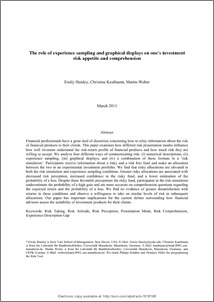|
The role of experience sampling and graphical displays on one's investment risk appetite and comprehension
Haisley, Emily Celia
;
Kaufmann, Christine
;
Weber, Martin
![[img]](https://madoc.bib.uni-mannheim.de/style/images/fileicons/application_pdf.png)  Vorschau |
|
PDF
SSRN-id1616186_WP175.pdf
- Veröffentlichte Version
Download (528kB)
|
|
URL:
|
https://ub-madoc.bib.uni-mannheim.de/31434
|
|
Weitere URL:
|
http://dx.doi.org/10.2139/ssrn.1616186
|
|
URN:
|
urn:nbn:de:bsz:180-madoc-314341
|
|
Dokumenttyp:
|
Arbeitspapier
|
|
Erscheinungsjahr:
|
2011
|
|
Titel einer Zeitschrift oder einer Reihe:
|
Working Paper / Lehrstuhl für Finanzierung, Universität Mannheim
|
|
Band/Volume:
|
175
|
|
Ort der Veröffentlichung:
|
Mannheim
|
|
Sprache der Veröffentlichung:
|
Englisch
|
|
Einrichtung:
|
Fakultät für Betriebswirtschaftslehre > ABWL u. Finanzwirtschaft, insbes. Bankbetriebslehre (Weber 1993-2017)
|
|
MADOC-Schriftenreihe:
|
Lehrstuhl für ABWL, Finanzwirtschaft, insb. Bankbetriebslehre (Weber) > Working Papers
|
|
Fachgebiet:
|
330 Wirtschaft
|
|
Fachklassifikation:
|
JEL:
G11,
|
|
Freie Schlagwörter (Englisch):
|
Risk taking , risk attitude , risk perception , presentation format , decision comprehension , experience-description gap
|
|
Abstract:
|
Financial professionals have a great deal of discretion concerning how to relay information about the risk of financial products to their clients. This paper examines how different risk presentation modes influence how well investors understand the risk-return profile of financial products and how much risk they are willing to accept. We analyze four different ways of communicating risk: (i) numerical descriptions, (ii) experience sampling, (iii) graphical displays, and (iv) a combination of these formats in a ‘risk simulation’. Participants receive information about a risky and a risk free fund and make an allocation between the two in an experimental investment portfolio. We find that risky allocations are elevated in both the risk simulation and experience sampling conditions. Greater risky allocations are associated with decreased risk perception, increased confidence in the risky fund, and a lower estimation of the probability of a loss. Despite these favorable perceptions the risky fund, participants in the risk simulation underestimate the probability of a high gain and are more accurate on comprehension questions regarding the expected return and the probability of a loss. We find no evidence of greater dissatisfaction with returns in these conditions and observe a willingness to take on similar levels of risk in subsequent allocations. Our paper has important implications for the current debate surrounding how financial advisors assess the suitability of investment products for their clients.
|
|
Zusätzliche Informationen:
|
Available at SSRN: http://ssrn.com/abstract=1616186 or http://dx.doi.org/10.2139/ssrn.1616186
|
 | Dieser Eintrag ist Teil der Universitätsbibliographie. |
 | Das Dokument wird vom Publikationsserver der Universitätsbibliothek Mannheim bereitgestellt. |
 Suche Autoren in Suche Autoren in
Sie haben einen Fehler gefunden? Teilen Sie uns Ihren Korrekturwunsch bitte hier mit: E-Mail
Actions (login required)
 |
Eintrag anzeigen |
|
|
 ORCID: 0000-0001-5018-3317
ORCID: 0000-0001-5018-3317



 Suche Autoren in
Suche Autoren in